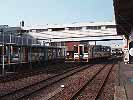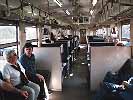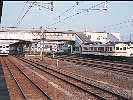
A light tank operated on a third sector railway located about 60 km north of Tokyo
By Hiroshi Naito
 |
| C1266 hauled steam train at Motegi terminus, the far end of the Mooka Railway. |
Mooka Railway is one of railfan destinations around Tokyo with weekend
steam operations. It uses 1933-built C1266, 2-6-2 tank, 50.1 tons, for
its steam operations. C1266 operated on several of JNR's rural lines
all over Japan and was withdrawn in 1972 after having run close to 2
million kilometers. It was on display then at a town in Fukushima
prefecture about 100 km north of Mooka, but in 1991, was acquired by
the Mooka Railway who intended to start steam operations to enhance its
business by attracting tourists and railfans. It was restored at JR
Omiya workshop and was put into revenue service in January 1994.
The Mooka Railway is located about 60 km north of Tokyo. The railway
originated in 1988 as a third sector railway, taking over the former
nation-owned Mooka line that was discontinued as a result of
privatization of the JNR. It runs along a 41.9 km route between
Shimodate on the JR Mito line and Motegi. The area the line serves is a
typical Japanese rural region stretching around the easternmost part of
the Kanto Plain, Tochigi prefecture. The railway was named after Mooka
city on the line, where its headquarters and depot are located. Another
distinctive town along the line is Mashiko, which is well known for its
intensive pottery industry.
Click here to see a map of Mooka Railway and its Vicinity
People in the
region tend to travel by automobile, or by buses, which frequently
operate to Utsunomiya, prefectural capital about 30 km west of the
line. Under these circumstances, steam operations are very important
for the railway company and the region to gather tourists, and thus
activating the region's community activity.
The steam service is on every Saturday and Sunday throughout the year,
and on particular days during busy tourist seasons, offering a 2 hours
and 20 minutes steam ride in each direction. In the service, the C12-66
hauls 3 coaches, two Oha-50s plus one Ohafu-50 in their dark brown
livery, purchased from JR East upon the commencement of steam service
in 1994.
The Type C12 was developed in 1932 to be used for short work on newly
built lightly-traveled lines in provincial areas. This is the second
lightest steam engine ever built in Japan following C56, 2-6 type
developed in 1935. 293 C12s were built in total in the 16 years between
1932 and 1947.
The photos contained in this page were taken when I went to Mooka, joining a JRS tour group from the UK in April this year.
C11325 joined the Mooka Railway's steam fleet in November 1998.
 A side view of C1266 taking a rest on a siding of Motegi terminus.
A side view of C1266 taking a rest on a siding of Motegi terminus.
 The C1266 on switching work at Motegi terminus to shun the steam train to the main track for the day's return trip.
The C1266 on switching work at Motegi terminus to shun the steam train to the main track for the day's return trip.
 A close up of the C1266's cab and water tank sides beautifully polished up in deep black.
A close up of the C1266's cab and water tank sides beautifully polished up in deep black.
 A view of the line's depot, at Mooka.
A view of the line's depot, at Mooka.
 A view inside a Ohafu 50 coach.
A view inside a Ohafu 50 coach.
 The C1266 hauled steam train resting at Mooka in front of the station building, featuring in the shape of a steam engine.
The C1266 hauled steam train resting at Mooka in front of the station building, featuring in the shape of a steam engine.
 A diesel hydraulic rail bus stationed at Shimodate terminus. The line's regular service fleet uses only this type of railcar.
A diesel hydraulic rail bus stationed at Shimodate terminus. The line's regular service fleet uses only this type of railcar.
 A rail bus at a loop with cherry blossom in full bloom in the background.
A rail bus at a loop with cherry blossom in full bloom in the background.
 A view of JR Shimodate station with single unit DMU of Kanto Railway whose route diverges the other way from this station.
A view of JR Shimodate station with single unit DMU of Kanto Railway whose route diverges the other way from this station.